Introduction to Human Resource Management Contents Introduction 2 Literature Review
VerifiedAdded on 2022/11/16
|14
|3509
|287
AI Summary
Borrowed ideas must be cited in the body of your project and that must correspond with your reference or bibliography.
Referencing should be in alphabetical order.
Contribute Materials
Your contribution can guide someone’s learning journey. Share your
documents today.
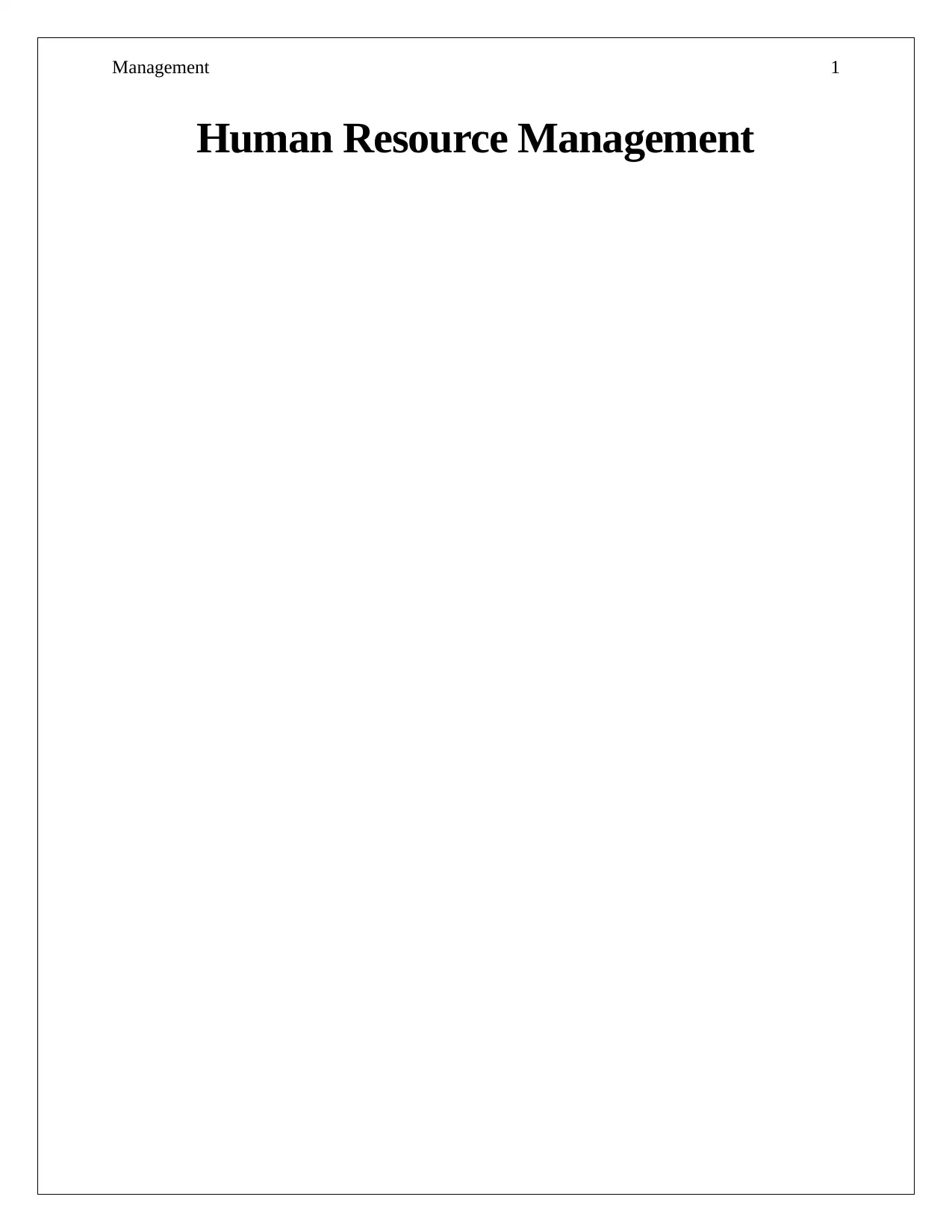
Management 1
Human Resource Management
Human Resource Management
Secure Best Marks with AI Grader
Need help grading? Try our AI Grader for instant feedback on your assignments.
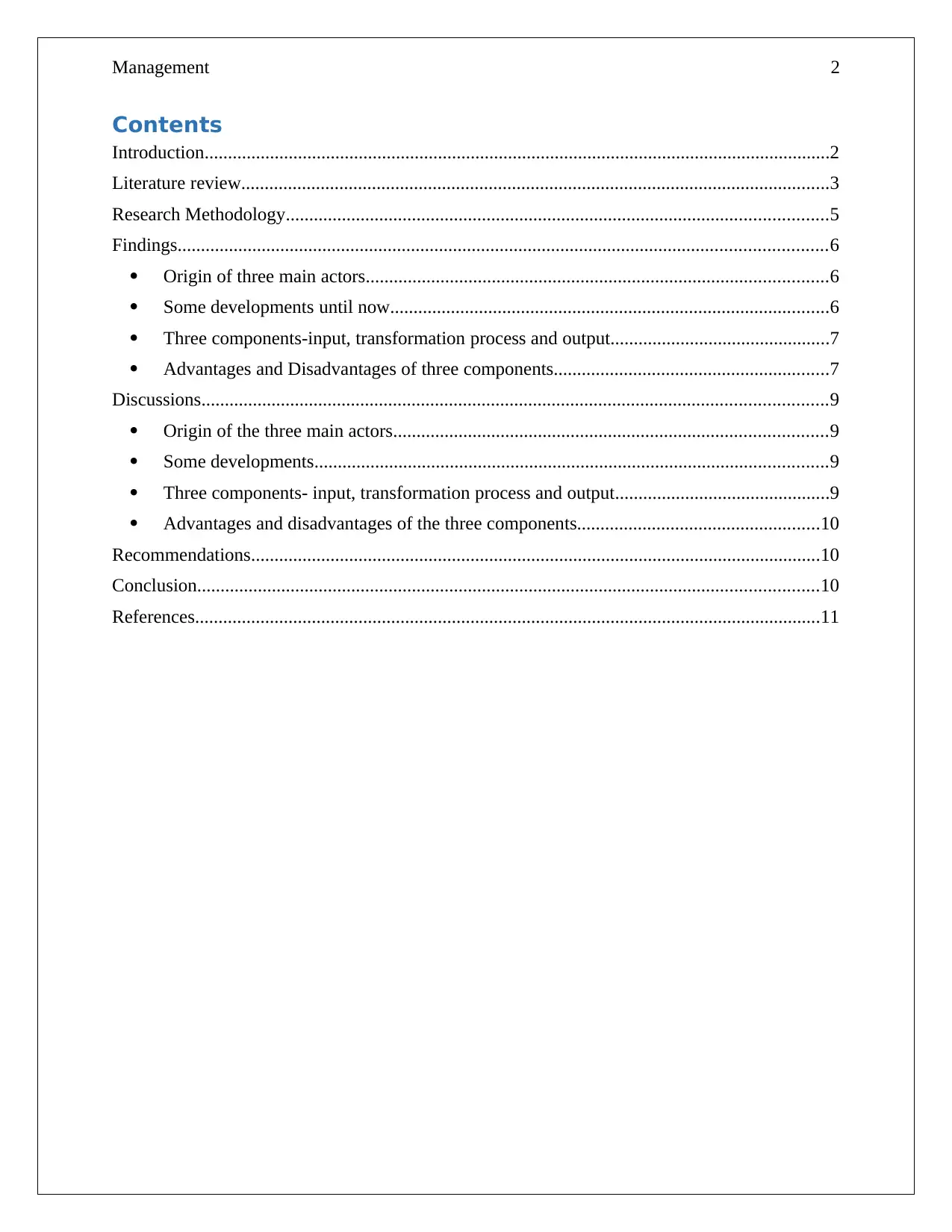
Management 2
Contents
Introduction......................................................................................................................................2
Literature review..............................................................................................................................3
Research Methodology....................................................................................................................5
Findings...........................................................................................................................................6
Origin of three main actors...................................................................................................6
Some developments until now..............................................................................................6
Three components-input, transformation process and output...............................................7
Advantages and Disadvantages of three components...........................................................7
Discussions......................................................................................................................................9
Origin of the three main actors.............................................................................................9
Some developments..............................................................................................................9
Three components- input, transformation process and output..............................................9
Advantages and disadvantages of the three components....................................................10
Recommendations..........................................................................................................................10
Conclusion.....................................................................................................................................10
References......................................................................................................................................11
Contents
Introduction......................................................................................................................................2
Literature review..............................................................................................................................3
Research Methodology....................................................................................................................5
Findings...........................................................................................................................................6
Origin of three main actors...................................................................................................6
Some developments until now..............................................................................................6
Three components-input, transformation process and output...............................................7
Advantages and Disadvantages of three components...........................................................7
Discussions......................................................................................................................................9
Origin of the three main actors.............................................................................................9
Some developments..............................................................................................................9
Three components- input, transformation process and output..............................................9
Advantages and disadvantages of the three components....................................................10
Recommendations..........................................................................................................................10
Conclusion.....................................................................................................................................10
References......................................................................................................................................11
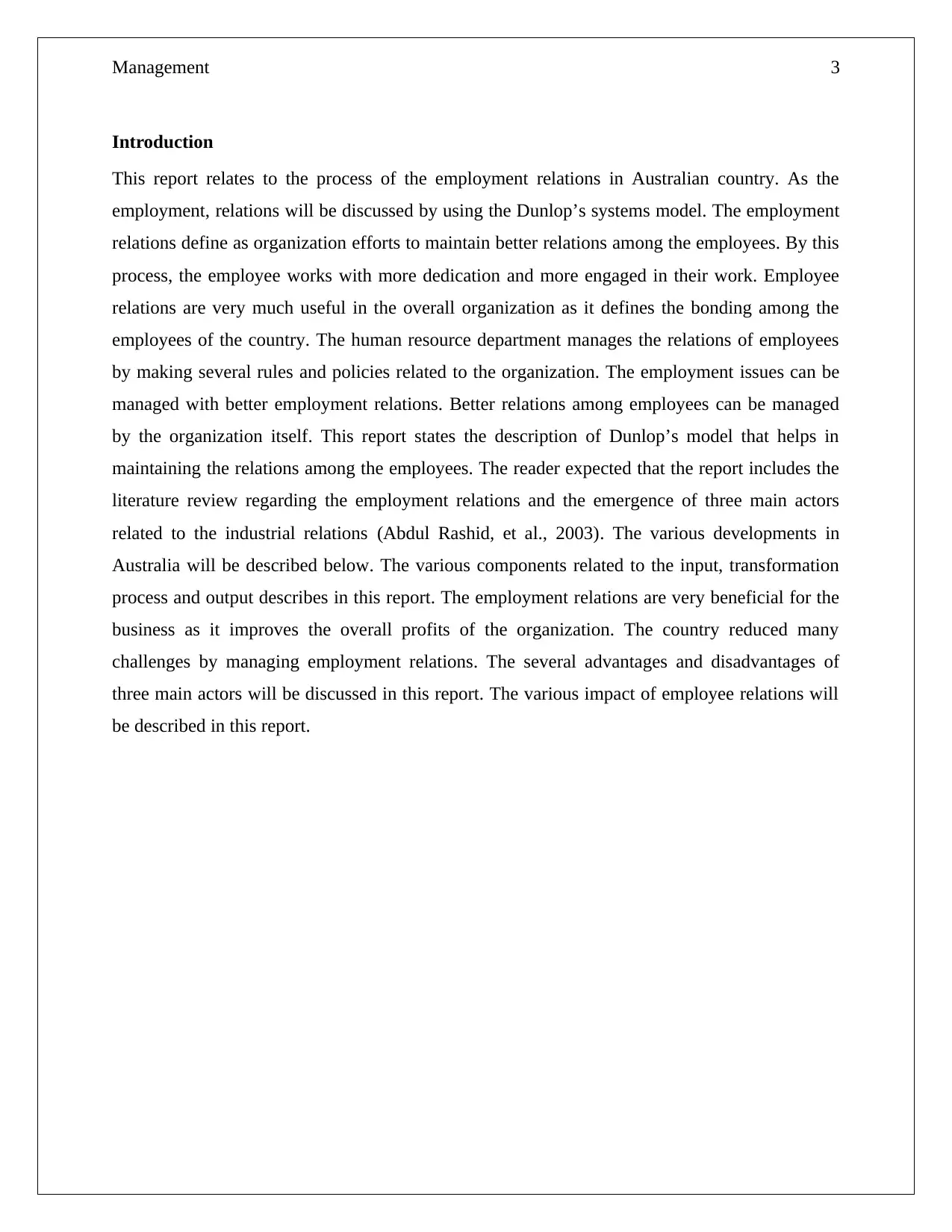
Management 3
Introduction
This report relates to the process of the employment relations in Australian country. As the
employment, relations will be discussed by using the Dunlop’s systems model. The employment
relations define as organization efforts to maintain better relations among the employees. By this
process, the employee works with more dedication and more engaged in their work. Employee
relations are very much useful in the overall organization as it defines the bonding among the
employees of the country. The human resource department manages the relations of employees
by making several rules and policies related to the organization. The employment issues can be
managed with better employment relations. Better relations among employees can be managed
by the organization itself. This report states the description of Dunlop’s model that helps in
maintaining the relations among the employees. The reader expected that the report includes the
literature review regarding the employment relations and the emergence of three main actors
related to the industrial relations (Abdul Rashid, et al., 2003). The various developments in
Australia will be described below. The various components related to the input, transformation
process and output describes in this report. The employment relations are very beneficial for the
business as it improves the overall profits of the organization. The country reduced many
challenges by managing employment relations. The several advantages and disadvantages of
three main actors will be discussed in this report. The various impact of employee relations will
be described in this report.
Introduction
This report relates to the process of the employment relations in Australian country. As the
employment, relations will be discussed by using the Dunlop’s systems model. The employment
relations define as organization efforts to maintain better relations among the employees. By this
process, the employee works with more dedication and more engaged in their work. Employee
relations are very much useful in the overall organization as it defines the bonding among the
employees of the country. The human resource department manages the relations of employees
by making several rules and policies related to the organization. The employment issues can be
managed with better employment relations. Better relations among employees can be managed
by the organization itself. This report states the description of Dunlop’s model that helps in
maintaining the relations among the employees. The reader expected that the report includes the
literature review regarding the employment relations and the emergence of three main actors
related to the industrial relations (Abdul Rashid, et al., 2003). The various developments in
Australia will be described below. The various components related to the input, transformation
process and output describes in this report. The employment relations are very beneficial for the
business as it improves the overall profits of the organization. The country reduced many
challenges by managing employment relations. The several advantages and disadvantages of
three main actors will be discussed in this report. The various impact of employee relations will
be described in this report.

Management 4
Literature review
According to Anitha (2014), an employment relation is the most effective way to manage the
relationship among the employees and increases the growth of the organization. The organization
makes several laws and regulations to maintain better relations among the employees of the
organization. In Australian country, the industrial relations are managed by making several act
and frameworks. The workplace relations play a significant role in Australian organizations. The
flexibility gives to the employees is also comes in the management of employee relations
(Ahmad and Schroeder, 2003. The Australia country follows several acts relating to
employment relations. The act includes several laws and regulations relating to industrial
relations. The act includes laws relates to the unfair employment termination .
As per the views of Gennard and Judge (2005), Industrial relations is the proper management of
the rules and obligations among the employers and the employees. The obligations included in
industrial relations are related to the work process of the organization. The Australian system
uses the Fair Work Act to manage employment relations. By managing employment relations,
the organization achieves overall growth and performance in the business market. The
constitution is very important in the management of employee relations. Australian industrial
relations are totally based on the constitution process. The employment relations are very
essential for the organization as it improves the overall performance of the employees and
increases their dedication towards the work.
According to Armstrong ( 2006), there are several theories used in the management of
employment relations in the country. The theories like Dunlop theories and unitary theories are
used to explain the employment relations. The unitary theories that working practices need to be
flexible and it improves the overall business process. By this theory, the efficiency is increased
in the organization. This theory describes that after the identification of union, the
communication can be managed among the staff and the organization. As per the theory, it is
determined that employee participation in the decisions maintains effective relations among
employees. Staffing policies play an important role in effective employment relations. By the
proper management of relations with the employees, using creative ideas and innovation in the
organization and improves the overall growth of the organization.
Literature review
According to Anitha (2014), an employment relation is the most effective way to manage the
relationship among the employees and increases the growth of the organization. The organization
makes several laws and regulations to maintain better relations among the employees of the
organization. In Australian country, the industrial relations are managed by making several act
and frameworks. The workplace relations play a significant role in Australian organizations. The
flexibility gives to the employees is also comes in the management of employee relations
(Ahmad and Schroeder, 2003. The Australia country follows several acts relating to
employment relations. The act includes several laws and regulations relating to industrial
relations. The act includes laws relates to the unfair employment termination .
As per the views of Gennard and Judge (2005), Industrial relations is the proper management of
the rules and obligations among the employers and the employees. The obligations included in
industrial relations are related to the work process of the organization. The Australian system
uses the Fair Work Act to manage employment relations. By managing employment relations,
the organization achieves overall growth and performance in the business market. The
constitution is very important in the management of employee relations. Australian industrial
relations are totally based on the constitution process. The employment relations are very
essential for the organization as it improves the overall performance of the employees and
increases their dedication towards the work.
According to Armstrong ( 2006), there are several theories used in the management of
employment relations in the country. The theories like Dunlop theories and unitary theories are
used to explain the employment relations. The unitary theories that working practices need to be
flexible and it improves the overall business process. By this theory, the efficiency is increased
in the organization. This theory describes that after the identification of union, the
communication can be managed among the staff and the organization. As per the theory, it is
determined that employee participation in the decisions maintains effective relations among
employees. Staffing policies play an important role in effective employment relations. By the
proper management of relations with the employees, using creative ideas and innovation in the
organization and improves the overall growth of the organization.
Secure Best Marks with AI Grader
Need help grading? Try our AI Grader for instant feedback on your assignments.
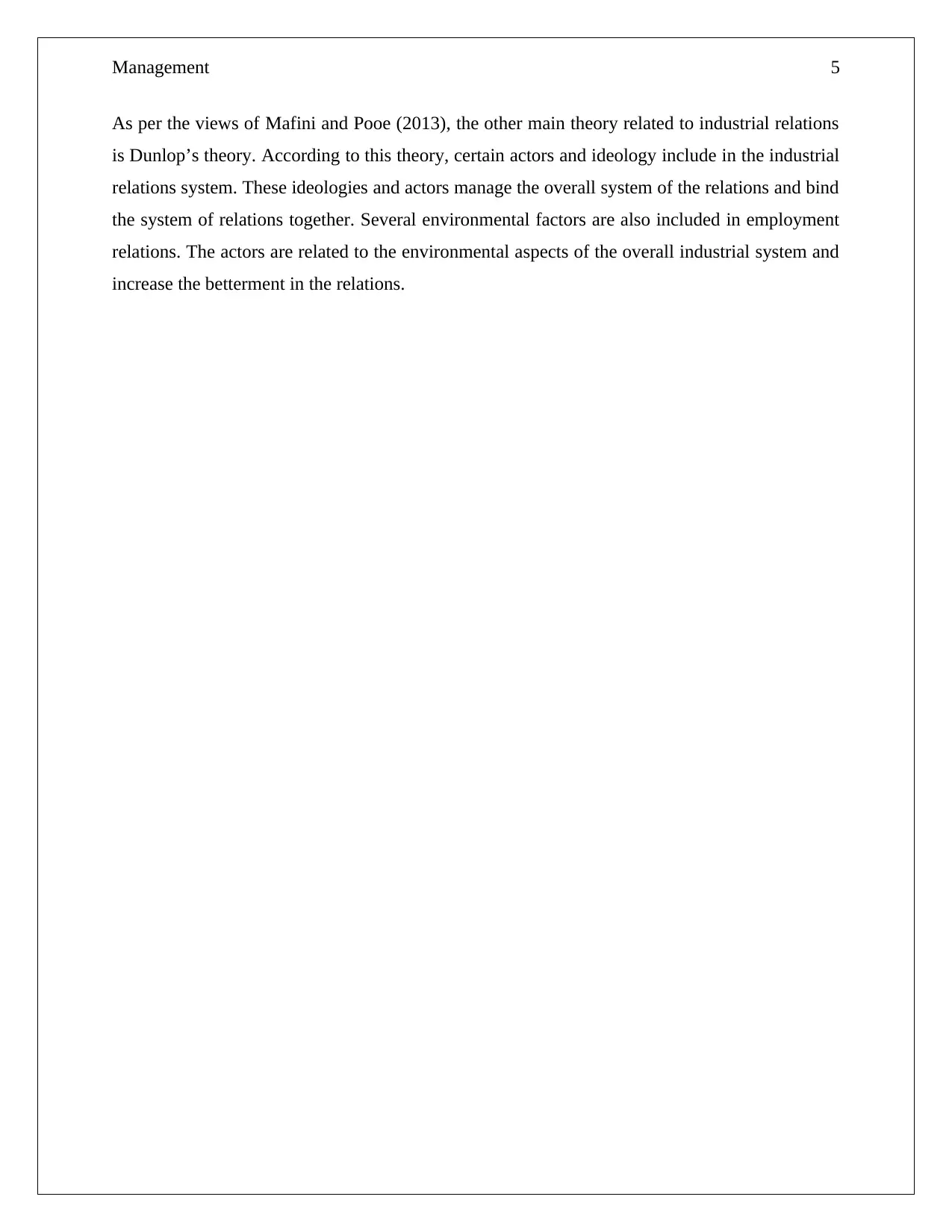
Management 5
As per the views of Mafini and Pooe (2013), the other main theory related to industrial relations
is Dunlop’s theory. According to this theory, certain actors and ideology include in the industrial
relations system. These ideologies and actors manage the overall system of the relations and bind
the system of relations together. Several environmental factors are also included in employment
relations. The actors are related to the environmental aspects of the overall industrial system and
increase the betterment in the relations.
As per the views of Mafini and Pooe (2013), the other main theory related to industrial relations
is Dunlop’s theory. According to this theory, certain actors and ideology include in the industrial
relations system. These ideologies and actors manage the overall system of the relations and bind
the system of relations together. Several environmental factors are also included in employment
relations. The actors are related to the environmental aspects of the overall industrial system and
increase the betterment in the relations.
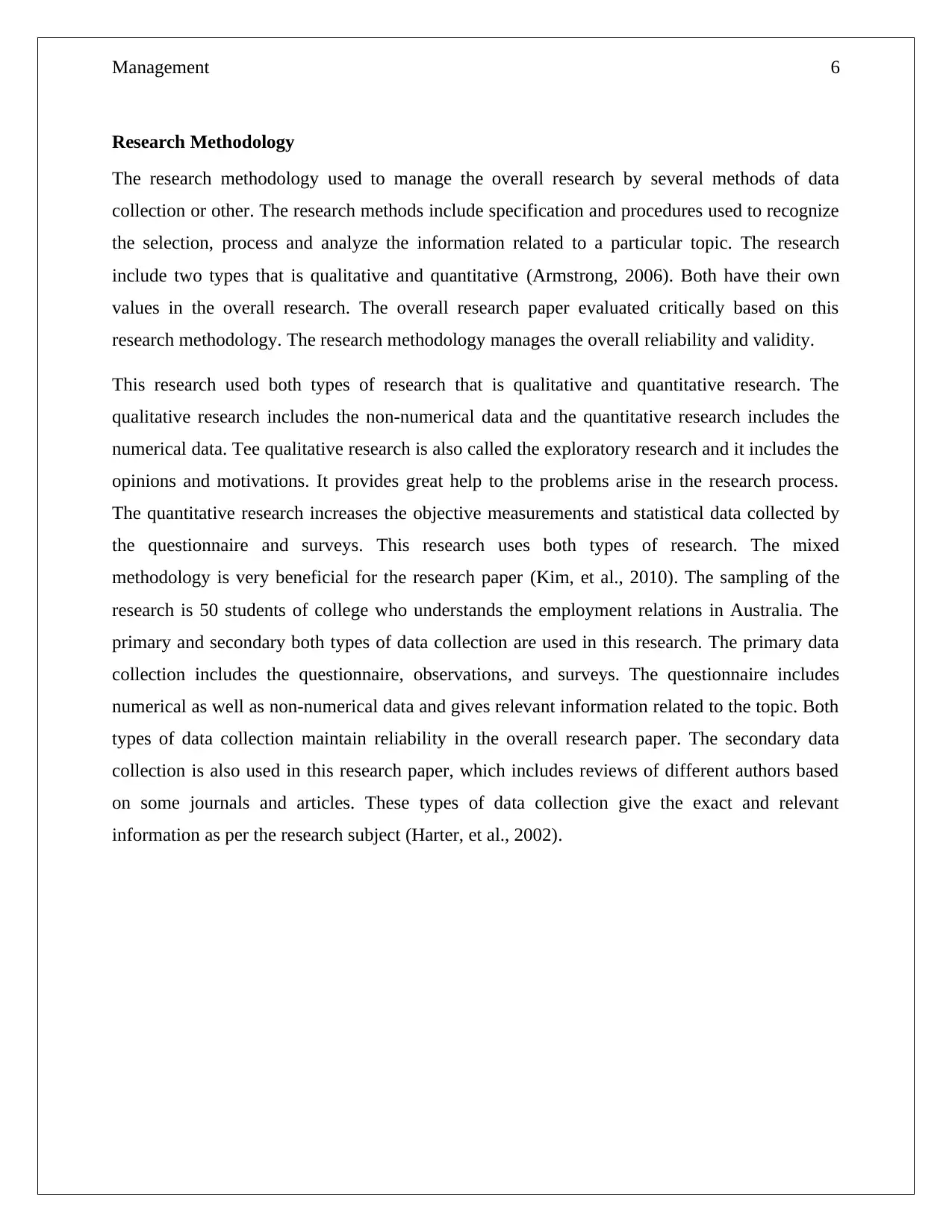
Management 6
Research Methodology
The research methodology used to manage the overall research by several methods of data
collection or other. The research methods include specification and procedures used to recognize
the selection, process and analyze the information related to a particular topic. The research
include two types that is qualitative and quantitative (Armstrong, 2006). Both have their own
values in the overall research. The overall research paper evaluated critically based on this
research methodology. The research methodology manages the overall reliability and validity.
This research used both types of research that is qualitative and quantitative research. The
qualitative research includes the non-numerical data and the quantitative research includes the
numerical data. Tee qualitative research is also called the exploratory research and it includes the
opinions and motivations. It provides great help to the problems arise in the research process.
The quantitative research increases the objective measurements and statistical data collected by
the questionnaire and surveys. This research uses both types of research. The mixed
methodology is very beneficial for the research paper (Kim, et al., 2010). The sampling of the
research is 50 students of college who understands the employment relations in Australia. The
primary and secondary both types of data collection are used in this research. The primary data
collection includes the questionnaire, observations, and surveys. The questionnaire includes
numerical as well as non-numerical data and gives relevant information related to the topic. Both
types of data collection maintain reliability in the overall research paper. The secondary data
collection is also used in this research paper, which includes reviews of different authors based
on some journals and articles. These types of data collection give the exact and relevant
information as per the research subject (Harter, et al., 2002).
Research Methodology
The research methodology used to manage the overall research by several methods of data
collection or other. The research methods include specification and procedures used to recognize
the selection, process and analyze the information related to a particular topic. The research
include two types that is qualitative and quantitative (Armstrong, 2006). Both have their own
values in the overall research. The overall research paper evaluated critically based on this
research methodology. The research methodology manages the overall reliability and validity.
This research used both types of research that is qualitative and quantitative research. The
qualitative research includes the non-numerical data and the quantitative research includes the
numerical data. Tee qualitative research is also called the exploratory research and it includes the
opinions and motivations. It provides great help to the problems arise in the research process.
The quantitative research increases the objective measurements and statistical data collected by
the questionnaire and surveys. This research uses both types of research. The mixed
methodology is very beneficial for the research paper (Kim, et al., 2010). The sampling of the
research is 50 students of college who understands the employment relations in Australia. The
primary and secondary both types of data collection are used in this research. The primary data
collection includes the questionnaire, observations, and surveys. The questionnaire includes
numerical as well as non-numerical data and gives relevant information related to the topic. Both
types of data collection maintain reliability in the overall research paper. The secondary data
collection is also used in this research paper, which includes reviews of different authors based
on some journals and articles. These types of data collection give the exact and relevant
information as per the research subject (Harter, et al., 2002).
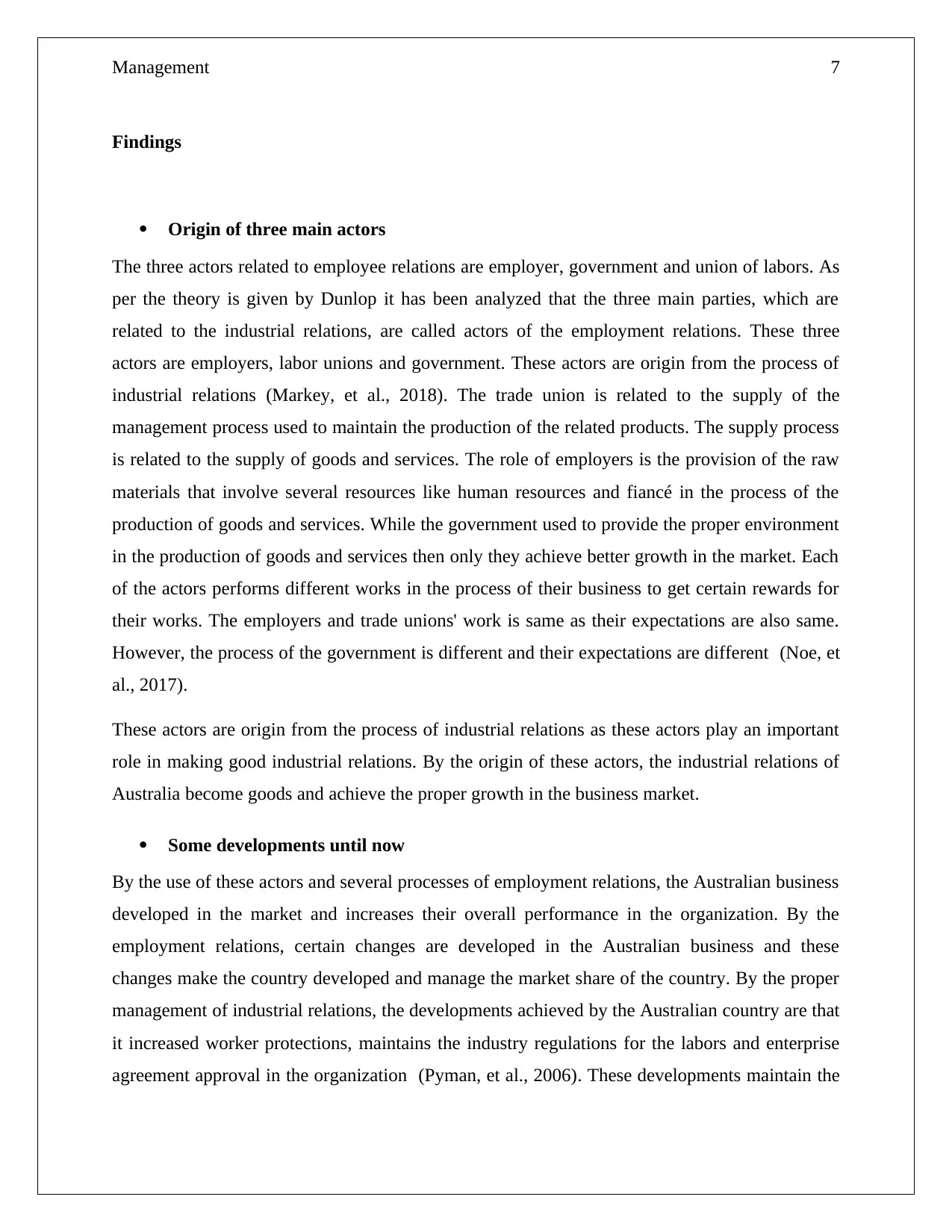
Management 7
Findings
Origin of three main actors
The three actors related to employee relations are employer, government and union of labors. As
per the theory is given by Dunlop it has been analyzed that the three main parties, which are
related to the industrial relations, are called actors of the employment relations. These three
actors are employers, labor unions and government. These actors are origin from the process of
industrial relations (Markey, et al., 2018). The trade union is related to the supply of the
management process used to maintain the production of the related products. The supply process
is related to the supply of goods and services. The role of employers is the provision of the raw
materials that involve several resources like human resources and fiancé in the process of the
production of goods and services. While the government used to provide the proper environment
in the production of goods and services then only they achieve better growth in the market. Each
of the actors performs different works in the process of their business to get certain rewards for
their works. The employers and trade unions' work is same as their expectations are also same.
However, the process of the government is different and their expectations are different (Noe, et
al., 2017).
These actors are origin from the process of industrial relations as these actors play an important
role in making good industrial relations. By the origin of these actors, the industrial relations of
Australia become goods and achieve the proper growth in the business market.
Some developments until now
By the use of these actors and several processes of employment relations, the Australian business
developed in the market and increases their overall performance in the organization. By the
employment relations, certain changes are developed in the Australian business and these
changes make the country developed and manage the market share of the country. By the proper
management of industrial relations, the developments achieved by the Australian country are that
it increased worker protections, maintains the industry regulations for the labors and enterprise
agreement approval in the organization (Pyman, et al., 2006). These developments maintain the
Findings
Origin of three main actors
The three actors related to employee relations are employer, government and union of labors. As
per the theory is given by Dunlop it has been analyzed that the three main parties, which are
related to the industrial relations, are called actors of the employment relations. These three
actors are employers, labor unions and government. These actors are origin from the process of
industrial relations (Markey, et al., 2018). The trade union is related to the supply of the
management process used to maintain the production of the related products. The supply process
is related to the supply of goods and services. The role of employers is the provision of the raw
materials that involve several resources like human resources and fiancé in the process of the
production of goods and services. While the government used to provide the proper environment
in the production of goods and services then only they achieve better growth in the market. Each
of the actors performs different works in the process of their business to get certain rewards for
their works. The employers and trade unions' work is same as their expectations are also same.
However, the process of the government is different and their expectations are different (Noe, et
al., 2017).
These actors are origin from the process of industrial relations as these actors play an important
role in making good industrial relations. By the origin of these actors, the industrial relations of
Australia become goods and achieve the proper growth in the business market.
Some developments until now
By the use of these actors and several processes of employment relations, the Australian business
developed in the market and increases their overall performance in the organization. By the
employment relations, certain changes are developed in the Australian business and these
changes make the country developed and manage the market share of the country. By the proper
management of industrial relations, the developments achieved by the Australian country are that
it increased worker protections, maintains the industry regulations for the labors and enterprise
agreement approval in the organization (Pyman, et al., 2006). These developments maintain the
Paraphrase This Document
Need a fresh take? Get an instant paraphrase of this document with our AI Paraphraser
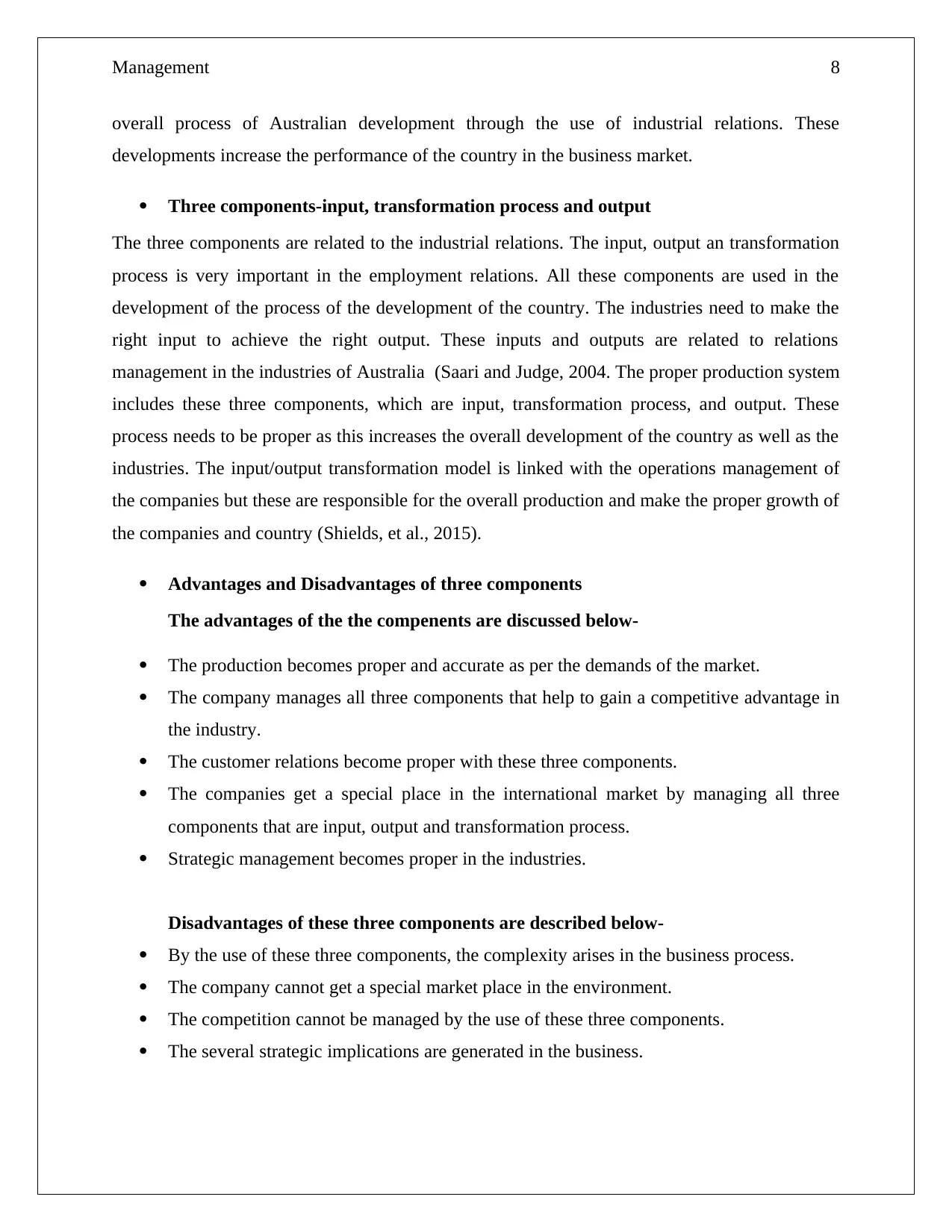
Management 8
overall process of Australian development through the use of industrial relations. These
developments increase the performance of the country in the business market.
Three components-input, transformation process and output
The three components are related to the industrial relations. The input, output an transformation
process is very important in the employment relations. All these components are used in the
development of the process of the development of the country. The industries need to make the
right input to achieve the right output. These inputs and outputs are related to relations
management in the industries of Australia (Saari and Judge, 2004. The proper production system
includes these three components, which are input, transformation process, and output. These
process needs to be proper as this increases the overall development of the country as well as the
industries. The input/output transformation model is linked with the operations management of
the companies but these are responsible for the overall production and make the proper growth of
the companies and country (Shields, et al., 2015).
Advantages and Disadvantages of three components
The advantages of the the compenents are discussed below-
The production becomes proper and accurate as per the demands of the market.
The company manages all three components that help to gain a competitive advantage in
the industry.
The customer relations become proper with these three components.
The companies get a special place in the international market by managing all three
components that are input, output and transformation process.
Strategic management becomes proper in the industries.
Disadvantages of these three components are described below-
By the use of these three components, the complexity arises in the business process.
The company cannot get a special market place in the environment.
The competition cannot be managed by the use of these three components.
The several strategic implications are generated in the business.
overall process of Australian development through the use of industrial relations. These
developments increase the performance of the country in the business market.
Three components-input, transformation process and output
The three components are related to the industrial relations. The input, output an transformation
process is very important in the employment relations. All these components are used in the
development of the process of the development of the country. The industries need to make the
right input to achieve the right output. These inputs and outputs are related to relations
management in the industries of Australia (Saari and Judge, 2004. The proper production system
includes these three components, which are input, transformation process, and output. These
process needs to be proper as this increases the overall development of the country as well as the
industries. The input/output transformation model is linked with the operations management of
the companies but these are responsible for the overall production and make the proper growth of
the companies and country (Shields, et al., 2015).
Advantages and Disadvantages of three components
The advantages of the the compenents are discussed below-
The production becomes proper and accurate as per the demands of the market.
The company manages all three components that help to gain a competitive advantage in
the industry.
The customer relations become proper with these three components.
The companies get a special place in the international market by managing all three
components that are input, output and transformation process.
Strategic management becomes proper in the industries.
Disadvantages of these three components are described below-
By the use of these three components, the complexity arises in the business process.
The company cannot get a special market place in the environment.
The competition cannot be managed by the use of these three components.
The several strategic implications are generated in the business.
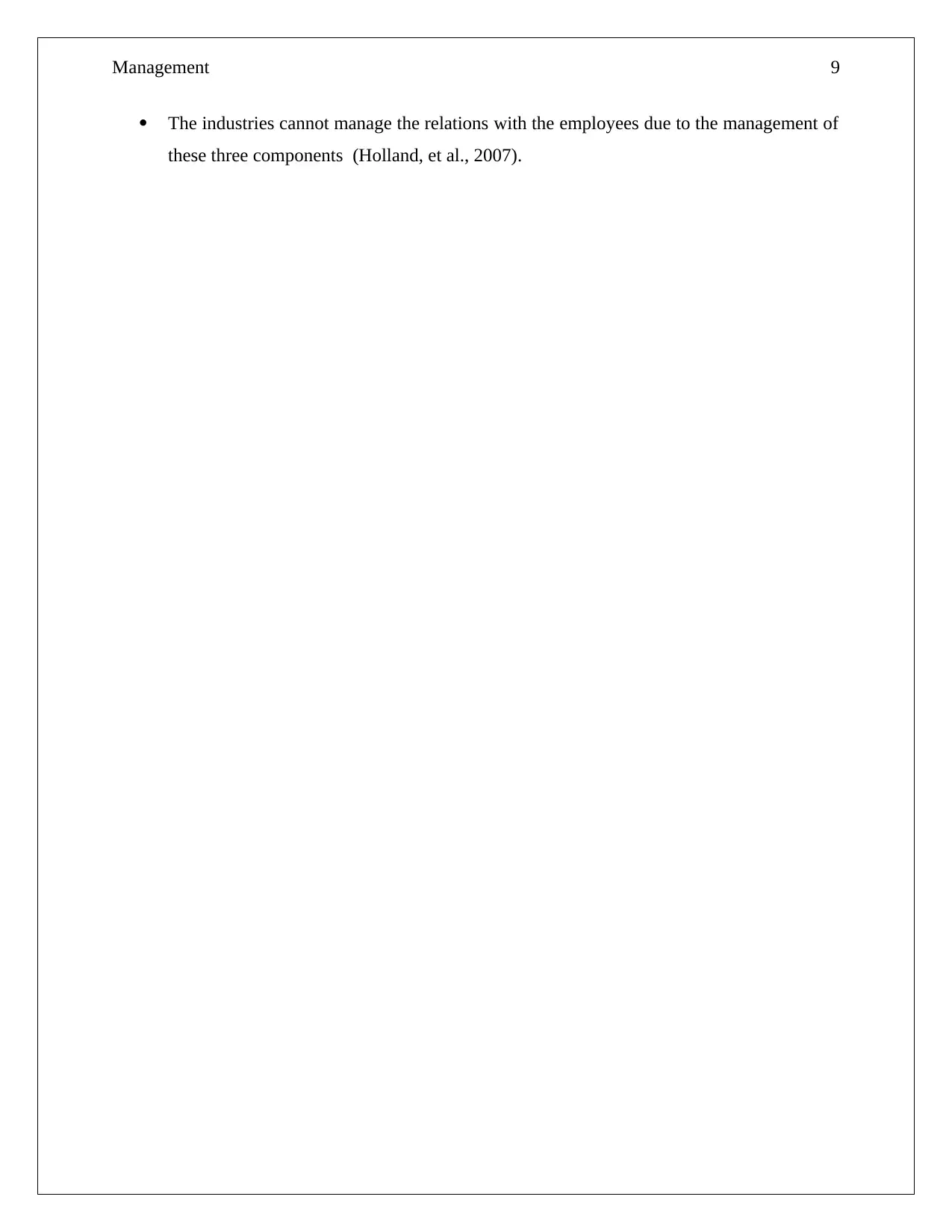
Management 9
The industries cannot manage the relations with the employees due to the management of
these three components (Holland, et al., 2007).
The industries cannot manage the relations with the employees due to the management of
these three components (Holland, et al., 2007).
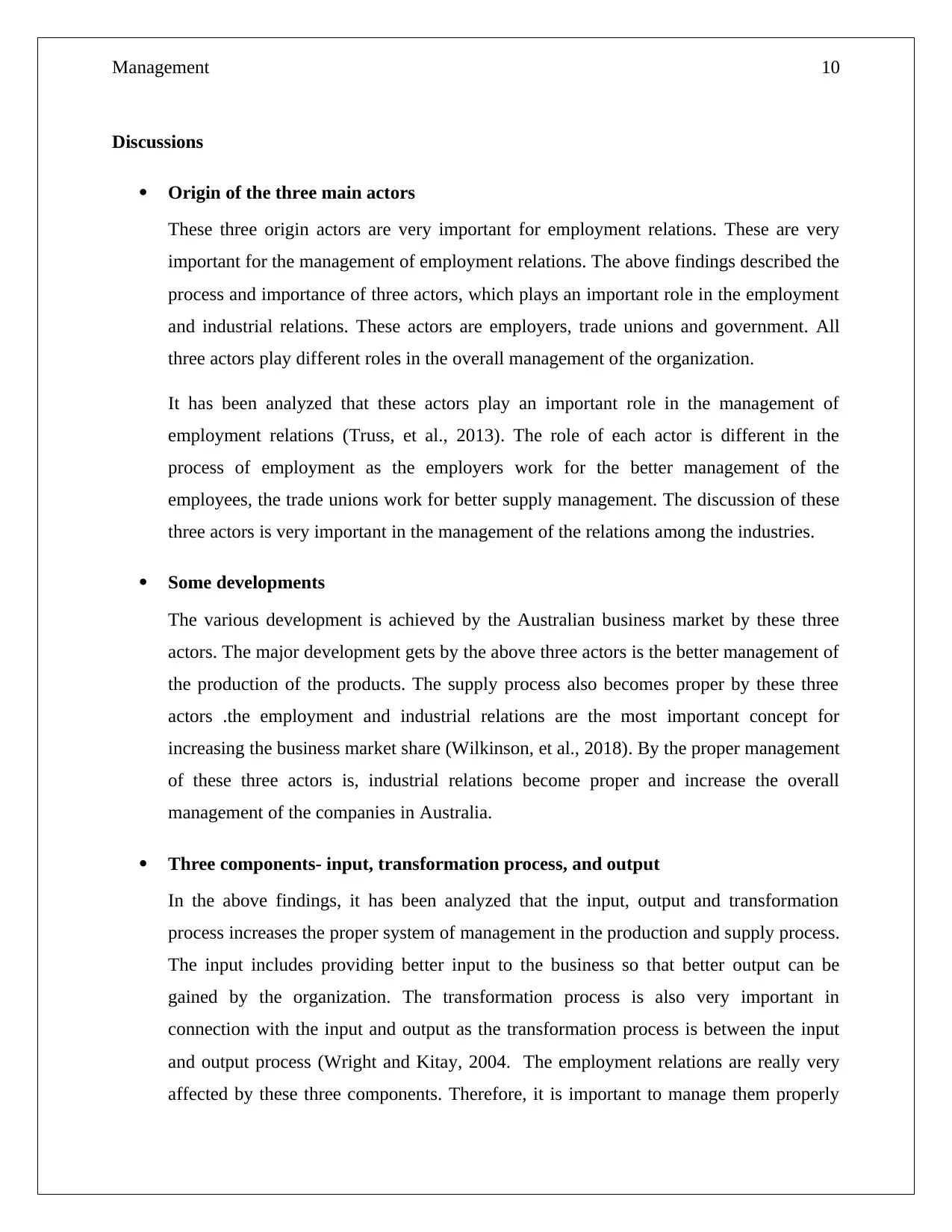
Management 10
Discussions
Origin of the three main actors
These three origin actors are very important for employment relations. These are very
important for the management of employment relations. The above findings described the
process and importance of three actors, which plays an important role in the employment
and industrial relations. These actors are employers, trade unions and government. All
three actors play different roles in the overall management of the organization.
It has been analyzed that these actors play an important role in the management of
employment relations (Truss, et al., 2013). The role of each actor is different in the
process of employment as the employers work for the better management of the
employees, the trade unions work for better supply management. The discussion of these
three actors is very important in the management of the relations among the industries.
Some developments
The various development is achieved by the Australian business market by these three
actors. The major development gets by the above three actors is the better management of
the production of the products. The supply process also becomes proper by these three
actors .the employment and industrial relations are the most important concept for
increasing the business market share (Wilkinson, et al., 2018). By the proper management
of these three actors is, industrial relations become proper and increase the overall
management of the companies in Australia.
Three components- input, transformation process, and output
In the above findings, it has been analyzed that the input, output and transformation
process increases the proper system of management in the production and supply process.
The input includes providing better input to the business so that better output can be
gained by the organization. The transformation process is also very important in
connection with the input and output as the transformation process is between the input
and output process (Wright and Kitay, 2004. The employment relations are really very
affected by these three components. Therefore, it is important to manage them properly
Discussions
Origin of the three main actors
These three origin actors are very important for employment relations. These are very
important for the management of employment relations. The above findings described the
process and importance of three actors, which plays an important role in the employment
and industrial relations. These actors are employers, trade unions and government. All
three actors play different roles in the overall management of the organization.
It has been analyzed that these actors play an important role in the management of
employment relations (Truss, et al., 2013). The role of each actor is different in the
process of employment as the employers work for the better management of the
employees, the trade unions work for better supply management. The discussion of these
three actors is very important in the management of the relations among the industries.
Some developments
The various development is achieved by the Australian business market by these three
actors. The major development gets by the above three actors is the better management of
the production of the products. The supply process also becomes proper by these three
actors .the employment and industrial relations are the most important concept for
increasing the business market share (Wilkinson, et al., 2018). By the proper management
of these three actors is, industrial relations become proper and increase the overall
management of the companies in Australia.
Three components- input, transformation process, and output
In the above findings, it has been analyzed that the input, output and transformation
process increases the proper system of management in the production and supply process.
The input includes providing better input to the business so that better output can be
gained by the organization. The transformation process is also very important in
connection with the input and output as the transformation process is between the input
and output process (Wright and Kitay, 2004. The employment relations are really very
affected by these three components. Therefore, it is important to manage them properly
Secure Best Marks with AI Grader
Need help grading? Try our AI Grader for instant feedback on your assignments.
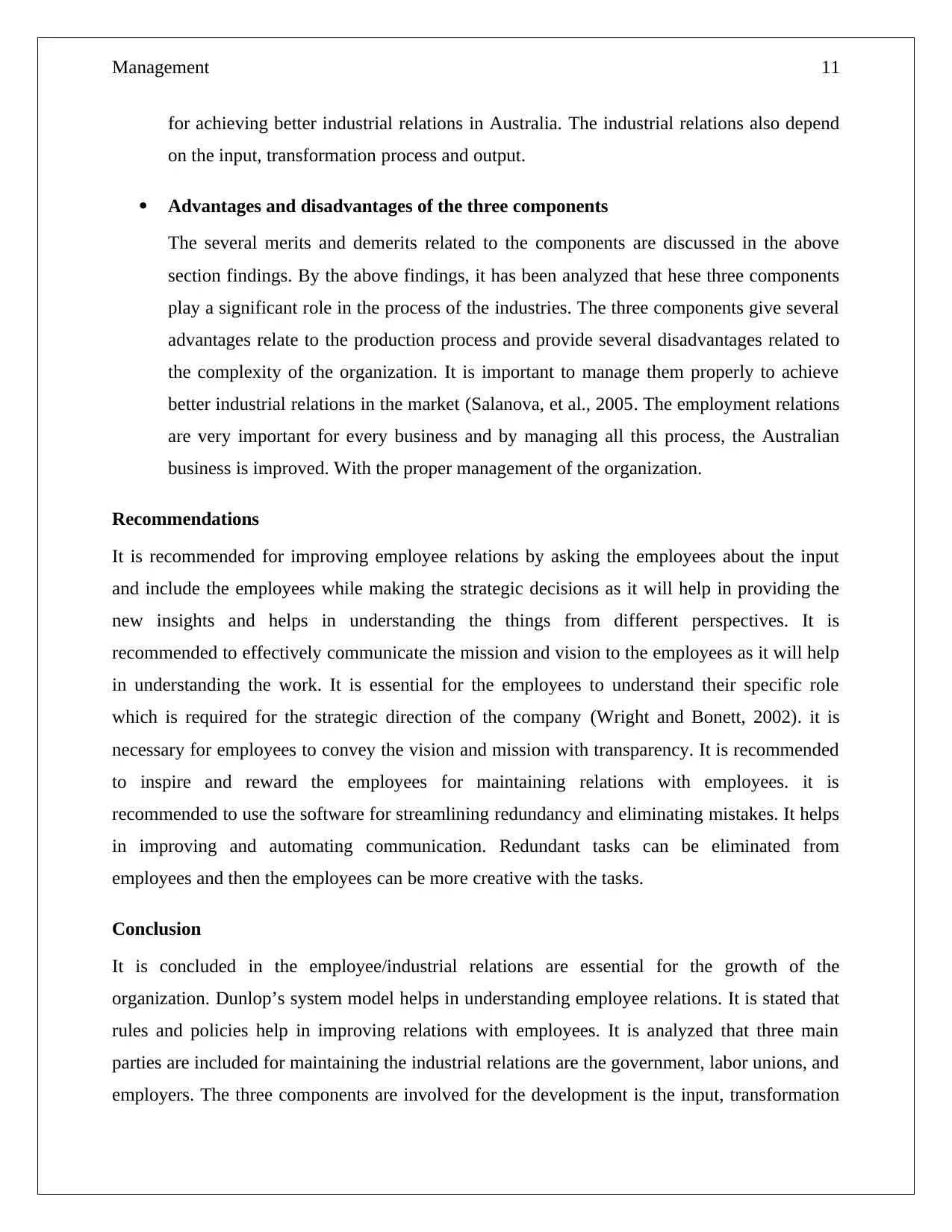
Management 11
for achieving better industrial relations in Australia. The industrial relations also depend
on the input, transformation process and output.
Advantages and disadvantages of the three components
The several merits and demerits related to the components are discussed in the above
section findings. By the above findings, it has been analyzed that hese three components
play a significant role in the process of the industries. The three components give several
advantages relate to the production process and provide several disadvantages related to
the complexity of the organization. It is important to manage them properly to achieve
better industrial relations in the market (Salanova, et al., 2005. The employment relations
are very important for every business and by managing all this process, the Australian
business is improved. With the proper management of the organization.
Recommendations
It is recommended for improving employee relations by asking the employees about the input
and include the employees while making the strategic decisions as it will help in providing the
new insights and helps in understanding the things from different perspectives. It is
recommended to effectively communicate the mission and vision to the employees as it will help
in understanding the work. It is essential for the employees to understand their specific role
which is required for the strategic direction of the company (Wright and Bonett, 2002). it is
necessary for employees to convey the vision and mission with transparency. It is recommended
to inspire and reward the employees for maintaining relations with employees. it is
recommended to use the software for streamlining redundancy and eliminating mistakes. It helps
in improving and automating communication. Redundant tasks can be eliminated from
employees and then the employees can be more creative with the tasks.
Conclusion
It is concluded in the employee/industrial relations are essential for the growth of the
organization. Dunlop’s system model helps in understanding employee relations. It is stated that
rules and policies help in improving relations with employees. It is analyzed that three main
parties are included for maintaining the industrial relations are the government, labor unions, and
employers. The three components are involved for the development is the input, transformation
for achieving better industrial relations in Australia. The industrial relations also depend
on the input, transformation process and output.
Advantages and disadvantages of the three components
The several merits and demerits related to the components are discussed in the above
section findings. By the above findings, it has been analyzed that hese three components
play a significant role in the process of the industries. The three components give several
advantages relate to the production process and provide several disadvantages related to
the complexity of the organization. It is important to manage them properly to achieve
better industrial relations in the market (Salanova, et al., 2005. The employment relations
are very important for every business and by managing all this process, the Australian
business is improved. With the proper management of the organization.
Recommendations
It is recommended for improving employee relations by asking the employees about the input
and include the employees while making the strategic decisions as it will help in providing the
new insights and helps in understanding the things from different perspectives. It is
recommended to effectively communicate the mission and vision to the employees as it will help
in understanding the work. It is essential for the employees to understand their specific role
which is required for the strategic direction of the company (Wright and Bonett, 2002). it is
necessary for employees to convey the vision and mission with transparency. It is recommended
to inspire and reward the employees for maintaining relations with employees. it is
recommended to use the software for streamlining redundancy and eliminating mistakes. It helps
in improving and automating communication. Redundant tasks can be eliminated from
employees and then the employees can be more creative with the tasks.
Conclusion
It is concluded in the employee/industrial relations are essential for the growth of the
organization. Dunlop’s system model helps in understanding employee relations. It is stated that
rules and policies help in improving relations with employees. It is analyzed that three main
parties are included for maintaining the industrial relations are the government, labor unions, and
employers. The three components are involved for the development is the input, transformation
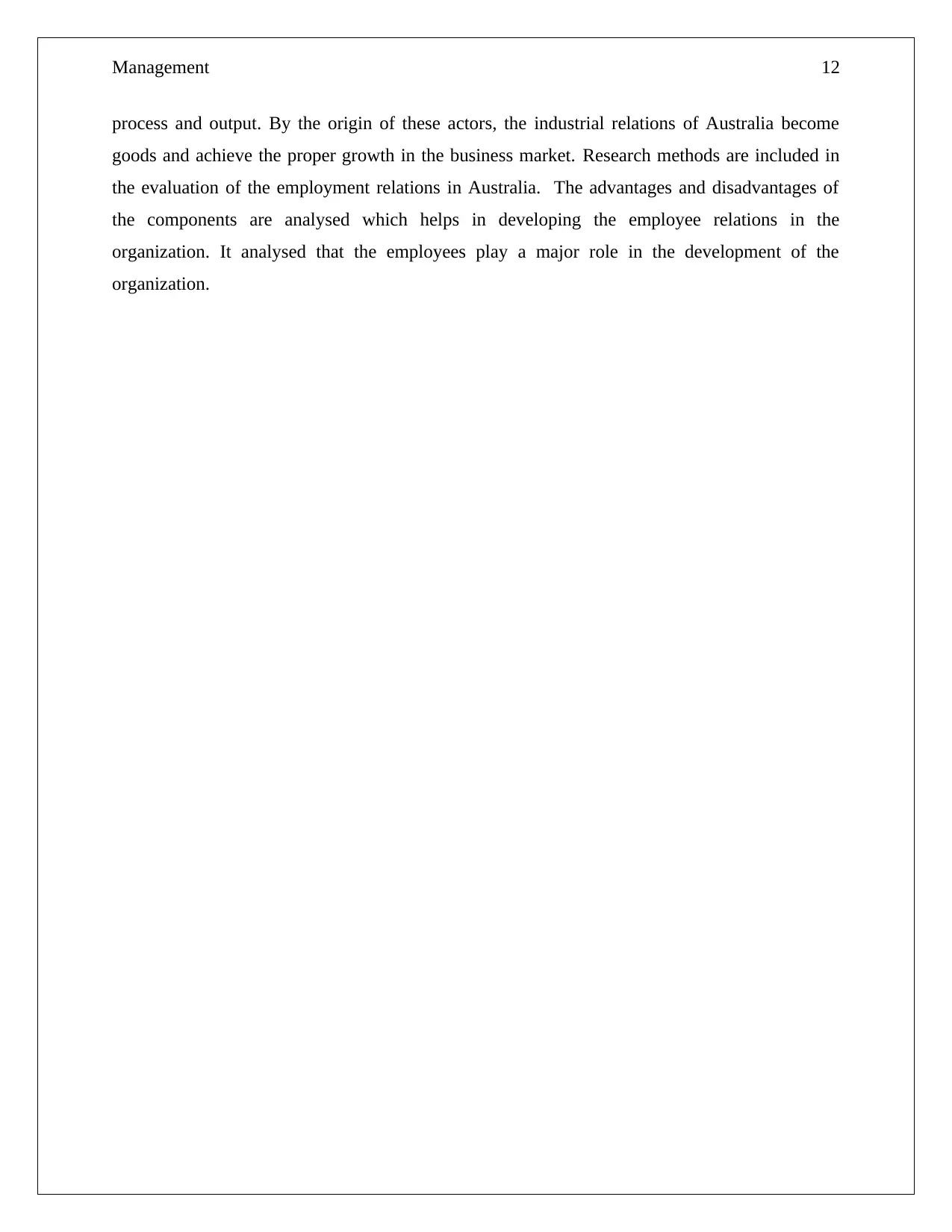
Management 12
process and output. By the origin of these actors, the industrial relations of Australia become
goods and achieve the proper growth in the business market. Research methods are included in
the evaluation of the employment relations in Australia. The advantages and disadvantages of
the components are analysed which helps in developing the employee relations in the
organization. It analysed that the employees play a major role in the development of the
organization.
process and output. By the origin of these actors, the industrial relations of Australia become
goods and achieve the proper growth in the business market. Research methods are included in
the evaluation of the employment relations in Australia. The advantages and disadvantages of
the components are analysed which helps in developing the employee relations in the
organization. It analysed that the employees play a major role in the development of the
organization.
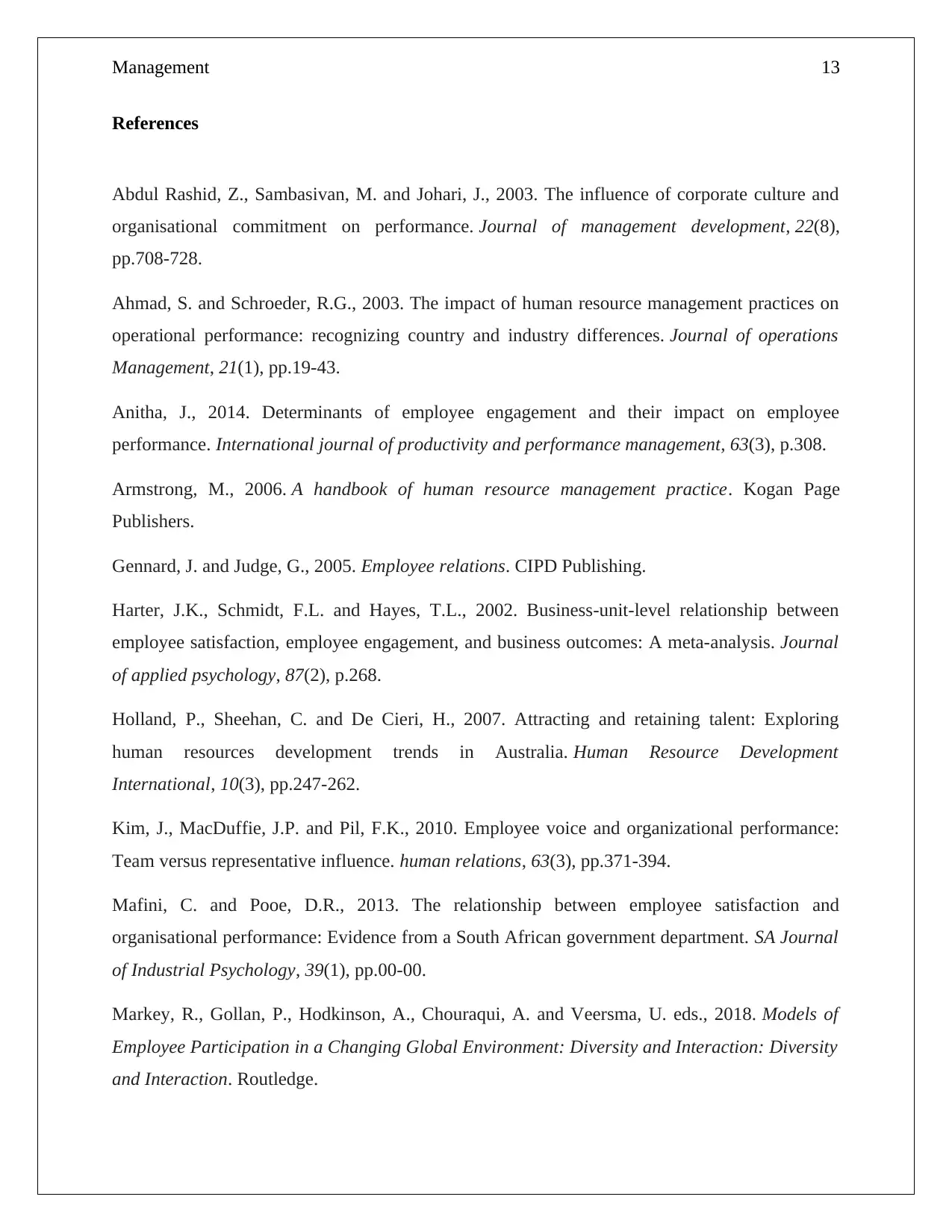
Management 13
References
Abdul Rashid, Z., Sambasivan, M. and Johari, J., 2003. The influence of corporate culture and
organisational commitment on performance. Journal of management development, 22(8),
pp.708-728.
Ahmad, S. and Schroeder, R.G., 2003. The impact of human resource management practices on
operational performance: recognizing country and industry differences. Journal of operations
Management, 21(1), pp.19-43.
Anitha, J., 2014. Determinants of employee engagement and their impact on employee
performance. International journal of productivity and performance management, 63(3), p.308.
Armstrong, M., 2006. A handbook of human resource management practice. Kogan Page
Publishers.
Gennard, J. and Judge, G., 2005. Employee relations. CIPD Publishing.
Harter, J.K., Schmidt, F.L. and Hayes, T.L., 2002. Business-unit-level relationship between
employee satisfaction, employee engagement, and business outcomes: A meta-analysis. Journal
of applied psychology, 87(2), p.268.
Holland, P., Sheehan, C. and De Cieri, H., 2007. Attracting and retaining talent: Exploring
human resources development trends in Australia. Human Resource Development
International, 10(3), pp.247-262.
Kim, J., MacDuffie, J.P. and Pil, F.K., 2010. Employee voice and organizational performance:
Team versus representative influence. human relations, 63(3), pp.371-394.
Mafini, C. and Pooe, D.R., 2013. The relationship between employee satisfaction and
organisational performance: Evidence from a South African government department. SA Journal
of Industrial Psychology, 39(1), pp.00-00.
Markey, R., Gollan, P., Hodkinson, A., Chouraqui, A. and Veersma, U. eds., 2018. Models of
Employee Participation in a Changing Global Environment: Diversity and Interaction: Diversity
and Interaction. Routledge.
References
Abdul Rashid, Z., Sambasivan, M. and Johari, J., 2003. The influence of corporate culture and
organisational commitment on performance. Journal of management development, 22(8),
pp.708-728.
Ahmad, S. and Schroeder, R.G., 2003. The impact of human resource management practices on
operational performance: recognizing country and industry differences. Journal of operations
Management, 21(1), pp.19-43.
Anitha, J., 2014. Determinants of employee engagement and their impact on employee
performance. International journal of productivity and performance management, 63(3), p.308.
Armstrong, M., 2006. A handbook of human resource management practice. Kogan Page
Publishers.
Gennard, J. and Judge, G., 2005. Employee relations. CIPD Publishing.
Harter, J.K., Schmidt, F.L. and Hayes, T.L., 2002. Business-unit-level relationship between
employee satisfaction, employee engagement, and business outcomes: A meta-analysis. Journal
of applied psychology, 87(2), p.268.
Holland, P., Sheehan, C. and De Cieri, H., 2007. Attracting and retaining talent: Exploring
human resources development trends in Australia. Human Resource Development
International, 10(3), pp.247-262.
Kim, J., MacDuffie, J.P. and Pil, F.K., 2010. Employee voice and organizational performance:
Team versus representative influence. human relations, 63(3), pp.371-394.
Mafini, C. and Pooe, D.R., 2013. The relationship between employee satisfaction and
organisational performance: Evidence from a South African government department. SA Journal
of Industrial Psychology, 39(1), pp.00-00.
Markey, R., Gollan, P., Hodkinson, A., Chouraqui, A. and Veersma, U. eds., 2018. Models of
Employee Participation in a Changing Global Environment: Diversity and Interaction: Diversity
and Interaction. Routledge.
Paraphrase This Document
Need a fresh take? Get an instant paraphrase of this document with our AI Paraphraser
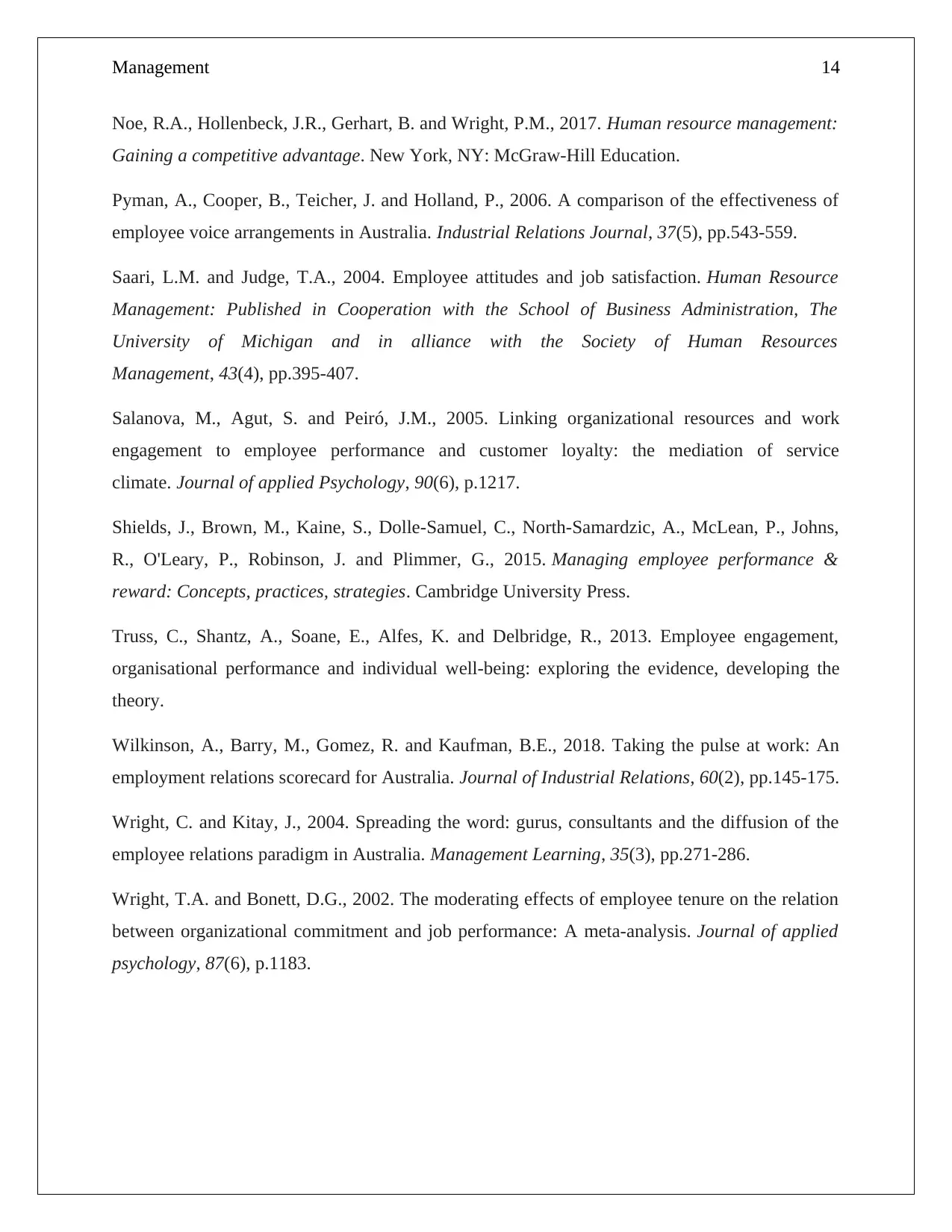
Management 14
Noe, R.A., Hollenbeck, J.R., Gerhart, B. and Wright, P.M., 2017. Human resource management:
Gaining a competitive advantage. New York, NY: McGraw-Hill Education.
Pyman, A., Cooper, B., Teicher, J. and Holland, P., 2006. A comparison of the effectiveness of
employee voice arrangements in Australia. Industrial Relations Journal, 37(5), pp.543-559.
Saari, L.M. and Judge, T.A., 2004. Employee attitudes and job satisfaction. Human Resource
Management: Published in Cooperation with the School of Business Administration, The
University of Michigan and in alliance with the Society of Human Resources
Management, 43(4), pp.395-407.
Salanova, M., Agut, S. and Peiró, J.M., 2005. Linking organizational resources and work
engagement to employee performance and customer loyalty: the mediation of service
climate. Journal of applied Psychology, 90(6), p.1217.
Shields, J., Brown, M., Kaine, S., Dolle-Samuel, C., North-Samardzic, A., McLean, P., Johns,
R., O'Leary, P., Robinson, J. and Plimmer, G., 2015. Managing employee performance &
reward: Concepts, practices, strategies. Cambridge University Press.
Truss, C., Shantz, A., Soane, E., Alfes, K. and Delbridge, R., 2013. Employee engagement,
organisational performance and individual well-being: exploring the evidence, developing the
theory.
Wilkinson, A., Barry, M., Gomez, R. and Kaufman, B.E., 2018. Taking the pulse at work: An
employment relations scorecard for Australia. Journal of Industrial Relations, 60(2), pp.145-175.
Wright, C. and Kitay, J., 2004. Spreading the word: gurus, consultants and the diffusion of the
employee relations paradigm in Australia. Management Learning, 35(3), pp.271-286.
Wright, T.A. and Bonett, D.G., 2002. The moderating effects of employee tenure on the relation
between organizational commitment and job performance: A meta-analysis. Journal of applied
psychology, 87(6), p.1183.
Noe, R.A., Hollenbeck, J.R., Gerhart, B. and Wright, P.M., 2017. Human resource management:
Gaining a competitive advantage. New York, NY: McGraw-Hill Education.
Pyman, A., Cooper, B., Teicher, J. and Holland, P., 2006. A comparison of the effectiveness of
employee voice arrangements in Australia. Industrial Relations Journal, 37(5), pp.543-559.
Saari, L.M. and Judge, T.A., 2004. Employee attitudes and job satisfaction. Human Resource
Management: Published in Cooperation with the School of Business Administration, The
University of Michigan and in alliance with the Society of Human Resources
Management, 43(4), pp.395-407.
Salanova, M., Agut, S. and Peiró, J.M., 2005. Linking organizational resources and work
engagement to employee performance and customer loyalty: the mediation of service
climate. Journal of applied Psychology, 90(6), p.1217.
Shields, J., Brown, M., Kaine, S., Dolle-Samuel, C., North-Samardzic, A., McLean, P., Johns,
R., O'Leary, P., Robinson, J. and Plimmer, G., 2015. Managing employee performance &
reward: Concepts, practices, strategies. Cambridge University Press.
Truss, C., Shantz, A., Soane, E., Alfes, K. and Delbridge, R., 2013. Employee engagement,
organisational performance and individual well-being: exploring the evidence, developing the
theory.
Wilkinson, A., Barry, M., Gomez, R. and Kaufman, B.E., 2018. Taking the pulse at work: An
employment relations scorecard for Australia. Journal of Industrial Relations, 60(2), pp.145-175.
Wright, C. and Kitay, J., 2004. Spreading the word: gurus, consultants and the diffusion of the
employee relations paradigm in Australia. Management Learning, 35(3), pp.271-286.
Wright, T.A. and Bonett, D.G., 2002. The moderating effects of employee tenure on the relation
between organizational commitment and job performance: A meta-analysis. Journal of applied
psychology, 87(6), p.1183.
1 out of 14
Related Documents
Your All-in-One AI-Powered Toolkit for Academic Success.
+13062052269
info@desklib.com
Available 24*7 on WhatsApp / Email
![[object Object]](/_next/static/media/star-bottom.7253800d.svg)
Unlock your academic potential
© 2024 | Zucol Services PVT LTD | All rights reserved.





